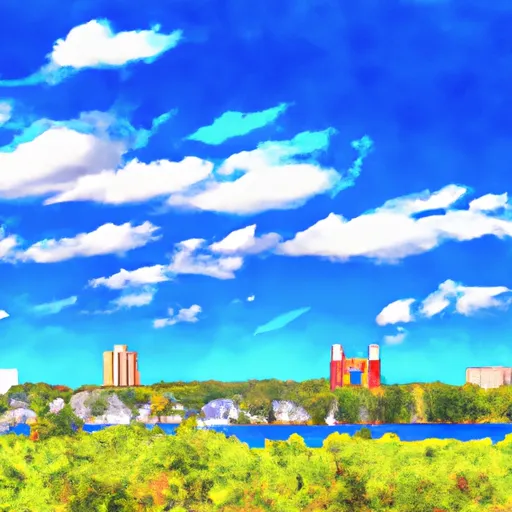-
 Snoflo Premium
Snoflo Premium
Get unlimited access to all our content
With no Ad interruptions! - Start Your Free Trial Login with existing account
Wind-Lake
Eden Index
Climate
8.6
•
Recreation
3.2
•
Community
4.6
•
Safeguard
5.7/10

Wind-Lake, Wisconsin is a picturesque small town situated in the heart of the state. The region experiences a humid continental climate, characterized by warm summers and cold winters. During the summer months, temperatures range from the mid-70s to low 80s Fahrenheit, while winter brings temperatures dropping to the mid-teens to low 20s Fahrenheit.
The town is blessed with numerous lakes and streams, making it a haven for water recreation enthusiasts. The hydrology constituents of Wind-Lake include the expansive Wind-Lake itself, which offers opportunities for swimming, boating, and fishing. The lake boasts a variety of fish species, such as bass, walleye, and pike, making it a popular destination for anglers.
In addition to Wind-Lake, the area is dotted with smaller lakes and streams, creating a picturesque landscape perfect for kayaking, canoeing, and paddleboarding. The surrounding forests provide ample opportunities for hiking, camping, and wildlife observation.
Overall, Wind-Lake, Wisconsin offers a diverse range of outdoor recreation opportunities, allowing visitors and residents alike to enjoy the natural beauty and tranquility of the area.
What is the Eden Index?
The Snoflo Eden Index serves as a comprehensive rating system for regions, evaluating their desirability through a holistic assessment of climate health, outdoor recreation opportunities, and natural disaster risk, acknowledging the profound impact of these factors on livability and well-being.
Climate Health Indicator (CHI): 8.6
Wind-Lake receives approximately
878mm of rain per year,
with humidity levels near 79%
and air temperatures averaging around
9°C.
Wind-Lake has a plant hardyness factor of
5, meaning
plants and agriculture in this region thrive during a short period during spring and early summer. Most
plants will die off during the colder winter months.
By considering the ideal temperature range, reliable water supplies, clean air, and stable seasonal rain or snowpacks, the Climate Health Indicator (CHI) underscores the significance of a healthy climate as the foundation for quality living.
A healthy climate is paramount for ensuring a high quality of life and livability in a region, fostering both physical well-being and environmental harmony. This can be characterized by ideal temperatures, reliable access to water supplies, clean air, and consistent seasonal rain or snowpacks.
Weather Forecast
Streamflow Conditions
Upper Illinois
Area Rivers
Upper Illinois
Snowpack Depths
Upper Illinois
Reservoir Storage Capacity
Upper Illinois
Groundwater Levels
Recreational Opportunity Index (ROI): 3.2
The Recreational Opportunity Index (ROI) recognizes the value of outdoor recreational options, such as parks, hiking trails, camping sites, and fishing spots, while acknowledging that climate plays a pivotal role in ensuring the comfort and consistency of these experiences.
Access to outdoor recreational opportunities, encompassing activities such as parks, hiking, camping, and fishing, is crucial for overall well-being, and the climate plays a pivotal role in enabling and enhancing these experiences, ensuring that individuals can engage in nature-based activities comfortably and consistently.
Camping Areas
| Campground | Campsites | Reservations | Toilets | Showers | Elevation |
|---|---|---|---|---|---|
| Sam Parr State Park | 80 | 524 ft | |||
| Nathan Bedford Forrest State Park | 53 | 437 ft | |||
| Rushing Creek - LBL | 56 | 402 ft | |||
| Piney - LBL | 300 | 385 ft | |||
| Gibson City Park | 4 | 731 ft | |||
| Oakland City Park | None | 653 ft | |||
| Fox Ridge State Park | 45 | 728 ft | |||
| Hilltop Campground - Grayville | None | 391 ft | |||
| Paris Landing State Park | 63 | 392 ft | |||
| Boswell Landing | 34 | 406 ft |
Nearby Ski Areas
Catastrophe Safeguard Index (CSI):
The Catastrophe Safeguard Index (CSI) recognizes that natural disaster risk, encompassing floods, fires, hurricanes, and tornadoes, can drastically affect safety and the overall appeal of an area.
The level of natural disaster risk in a region significantly affects safety and the overall livability, with climate change amplifying these risks by potentially increasing the frequency and intensity of events like floods, fires, hurricanes, and tornadoes, thereby posing substantial challenges to community resilience and well-being.
Community Resilience Indicator (CRI): 4.6
The Community Resilience Indicator (CRI) recognizes that education, healthcare, and socioeconomics are crucial to the well-being of a region. The CRI acknowledges the profound impact of these elements on residents' overall quality of life. By evaluating educational resources, healthcare accessibility, and economic inclusivity, the index captures the essential aspects that contribute to a thriving community, fostering resident satisfaction, equity, and social cohesion.

